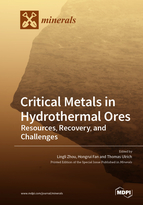Critical Metals in Hydrothermal Ores: Resources, Recovery, and Challenges
A special issue of Minerals (ISSN 2075-163X). This special issue belongs to the section "Mineral Deposits".
Deadline for manuscript submissions: closed (15 October 2020) | Viewed by 49170
Special Issue Editors
Interests: critical metals; geochemistry; analytical mineralogy
Interests: rare earth deposits; gold deposits; hydrothermal fluids
Special Issue Information
Dear Colleagues,
‘Critical’ or ’strategic’ metals are essential for the development of society and technologies; however, they are vulnerable to imbalances between supply and demand. An advanced understanding of the mineralogy and distribution of critical metals in hydrothermal ores is crucial for the exploitation of ores in which these elements are present at low concentrations, or are to be produced as a by-product from mining operations principally targeting other, more abundant commodities. Contributions focused on geochemistry, mineralogy, metallurgy, genesis and the exploration of critical metals in hydrothermal systems are encouraged for this Special Issue. Topics will encompass the new and novel understanding of critical metals in hydrothermal ores from a range of systems. These systems include, but are not limited to, VMS and marine hydrothermal systems, IOCG and IOA deposits, Pb-Zn deposits and other basin-hosted mineralisation and polymetallic deposits. The areas of interest include: traditional and non-traditional analytical approaches advancing critical metal characterization; the genesis of critical metals, geochemical behaviours of critical metals in simple and complex multi-sulphide systems, or where the critical metals are potentially also present in oxides, silicates or other co-existing minerals; techniques for extracting critical metals from hydrothermal ores; metal criticality assessment; challenges with respect to the responsible sourcing of critical metals from hydrothermal ores.
Dr. Lingli Zhou
Prof. Dr. Hongrui Fan
Dr. Thomas Ulrich
Guest Editors
Manuscript Submission Information
Manuscripts should be submitted online at www.mdpi.com by registering and logging in to this website. Once you are registered, click here to go to the submission form. Manuscripts can be submitted until the deadline. All submissions that pass pre-check are peer-reviewed. Accepted papers will be published continuously in the journal (as soon as accepted) and will be listed together on the special issue website. Research articles, review articles as well as short communications are invited. For planned papers, a title and short abstract (about 100 words) can be sent to the Editorial Office for announcement on this website.
Submitted manuscripts should not have been published previously, nor be under consideration for publication elsewhere (except conference proceedings papers). All manuscripts are thoroughly refereed through a single-blind peer-review process. A guide for authors and other relevant information for submission of manuscripts is available on the Instructions for Authors page. Minerals is an international peer-reviewed open access monthly journal published by MDPI.
Please visit the Instructions for Authors page before submitting a manuscript. The Article Processing Charge (APC) for publication in this open access journal is 2400 CHF (Swiss Francs). Submitted papers should be well formatted and use good English. Authors may use MDPI's English editing service prior to publication or during author revisions.
Keywords
- critical metals
- hydrothermal process
- geochemistry
- mineralogy
- mineral processing
- metal criticality assessment
- energy, resource and society








